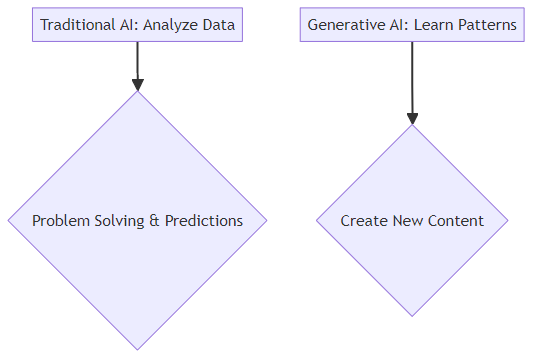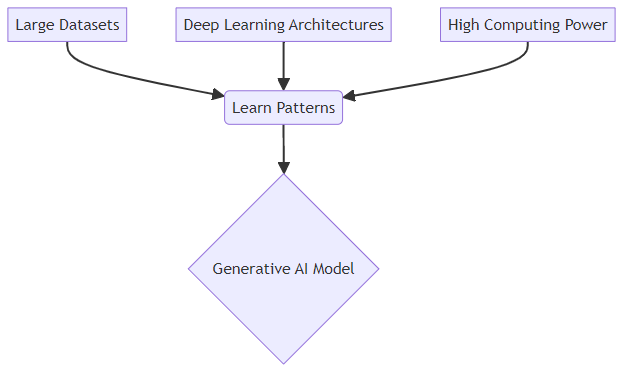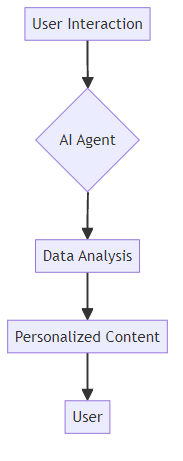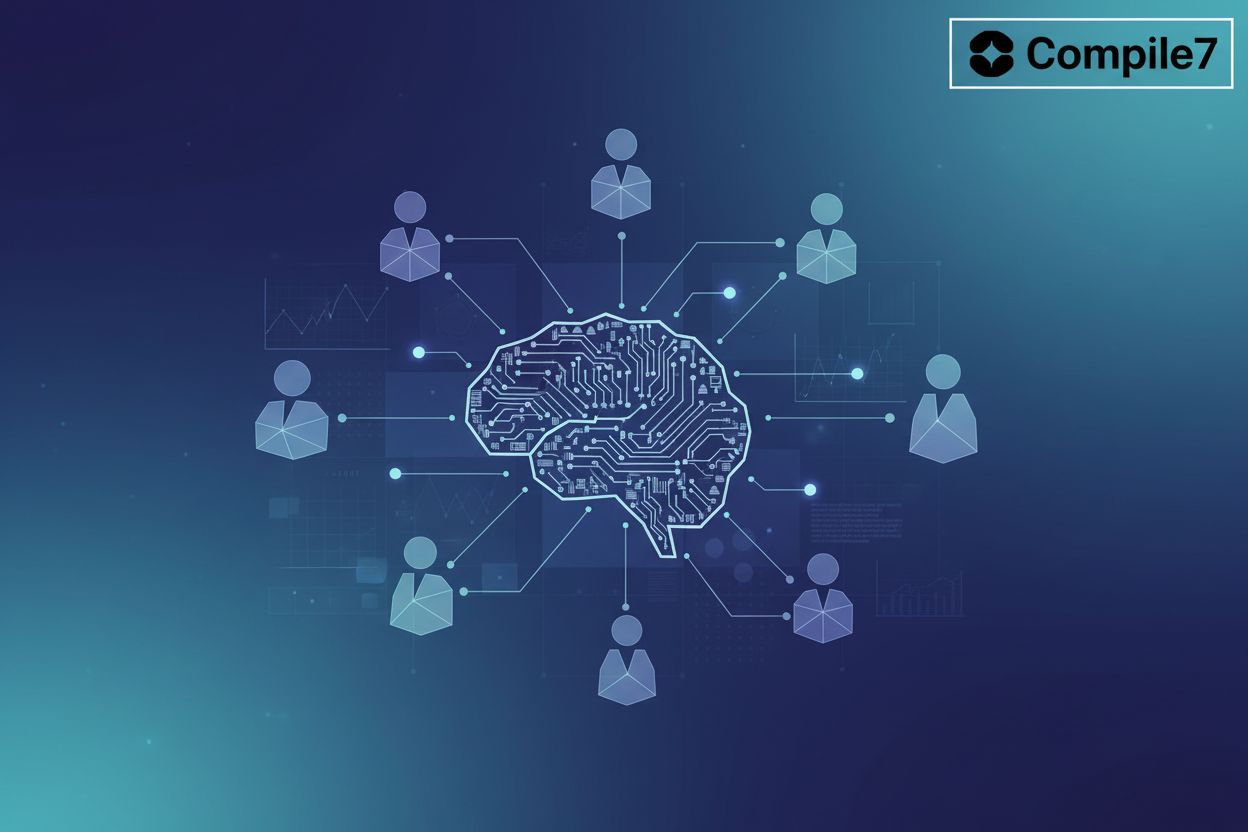Reimagine Your Business: How AI-Enabled Business Process Reengineering Drives Transformation
Revolutionizing Content Personalization: How Generative AI and AI Agents are Transforming Business
The Rise of Personalized Content and the Generative AI Revolution
Did you know that 71% of consumers feel frustrated when an experience is not personalized (Unlocking the next frontier of personalized marketing - McKinsey)? This highlights the critical need for tailored content in today's digital landscape. This section explores the increasing demand for personalized experiences and how generative ai is revolutionizing content creation to meet these expectations.
Consumers now expect content tailored to their needs and preferences. They want interactions that feel relevant and understand their unique context.
- Tailored Content: Customers expect brands to understand their individual preferences and provide content that resonates with them. For example, a healthcare provider could use ai to create personalized wellness plans.
- Engagement and Loyalty: Personalization drives higher engagement rates, increased conversion rates, and stronger customer loyalty. A retailer, for instance, could offer customized product recommendations.
- Limitations of Traditional Methods: Traditional personalization methods often struggle with scalability and limited data insights. Generative ai addresses these limitations by enabling hyper-personalization at scale.
Generative ai possesses the unique ability to create novel content across various formats. This capability marks a significant shift in how businesses approach content personalization.
- Content Creation: Generative ai can create new content from text, images, audio, and video. This allows for diverse and engaging personalized experiences.
- Novel Outputs: Unlike traditional ai, generative ai produces entirely new outputs based on learned patterns. This goes beyond simple analysis and prediction, offering true content creation.
- Hyper-Personalization at Scale: The ability to generate unique content enables hyper-personalization at scale, overcoming traditional methods' limitations. For example, a financial service could use ai to generate tailored investment advice. Generative ai achieves this by dynamically creating content variations based on granular user data—like past purchases, browsing history, or even real-time context like location or time of day—going far beyond static, pre-defined templates. It can rewrite a product description to highlight features a specific user has shown interest in, or generate an email subject line that directly addresses a recent customer query.
The distinction between generative ai and traditional ai lies in their approach to data and content creation. Generative ai operates in an open loop, creating new content.
- Traditional AI: Traditional ai analyzes existing data for problem-solving and predictions, operating in a closed loop. It is for tasks like spam filtering.
- Generative AI: Generative ai learns from data patterns to create new content in an open loop. This includes generating images from text descriptions.
- Democratization of Content Creation: Generative ai makes content creation more accessible to developers and creators. This empowers a broader range of users to leverage ai for various applications.

As we move forward, it's important to understand how ai agents leverage generative ai to automate and enhance business processes. The next section will delve into this exciting intersection.
Unlocking the Power of Generative AI for Content Personalization
Did you know that generative ai models require vast amounts of data to learn patterns and create effective content? These models are revolutionizing content personalization, but understanding their building blocks is crucial. Let's dive into the core components that power this technology.
Large datasets are the foundation upon which generative ai models are built. Without extensive data, these models cannot learn the intricate patterns necessary to create high-quality content. The Rise of Generative AI notes that these models require vast amounts of data to learn patterns and create new content effectively.
Deep learning architectures are also essential. Techniques like Generative Adversarial Networks (GANs) and Transformers are commonly used to train these models. These architectures allow the ai to understand and replicate complex data structures.
Generative models require vast amounts of data to learn patterns and create new content effectively.
Training generative models demands significant computing power. Powerful hardware resources, such as Graphics Processing Units (GPUs), are necessary to handle the computationally intensive processes involved. Efficient training ensures that the models can learn quickly and accurately.

Generative ai is no longer limited to single data types. It's evolving to handle a wider range of inputs and outputs, enabling more versatile applications. This versatility paves the way for ai assistants to seamlessly integrate various functions, enhancing user experiences across industries.
Advancements in Natural Language Processing (NLP) are empowering generative ai to produce high-quality and controlled text content. These advancements enable ai to craft various content styles, translate languages accurately, and compose creative text formats.
Diffusion models are pushing the boundaries in high-fidelity image and video generation. Models like Google’s Lumiere allow video creation from text descriptions, modifying existing images based on user input, and generating entirely new images with exceptional detail. These advancements hold tremendous potential in media creation, entertainment, and product design.
These technical components—large datasets, sophisticated architectures, powerful computing, and advanced NLP and diffusion models—form the bedrock of generative ai's ability to create dynamic, personalized content. Understanding these building blocks is key to appreciating how they translate into tangible, real-world applications that are reshaping how businesses connect with their audiences.
Now that we’ve explored the building blocks and expanding scope of generative ai, the next section will cover how ai agents are leveraging these advancements to transform business processes.
Real-World Applications: Generative AI in Action
Generative ai is already impacting industries as diverse as healthcare and retail. Let's explore how businesses are using this technology to create personalized experiences and streamline operations.
Generative ai is transforming marketing by enabling the creation of highly targeted content that resonates with specific audiences. This approach ensures that marketing messages are not only more relevant but also optimized for different channels. Companies now use generative ai tools to craft product descriptions, social media posts, and personalized marketing copy, enhancing customer engagement and driving conversions.
Personalized prompts enable the creation of engaging emails tailored to individual customer interests, leading to higher open rates and click-through rates. For example, a customer who previously purchased running shoes might receive an email featuring new athletic apparel or related fitness products. The ability to personalize content at scale is a game-changer for marketers, allowing them to deliver experiences that feel both personal and relevant.
Generative AI is not just a technological advancement but a transformative force that is reshaping business practices and opening up new possibilities across industries.
Generative ai can generate human-like responses for customer service chatbots, leading to improved engagement and satisfaction. These chatbots provide personalized recommendations and solutions based on customer data. For instance, a chatbot can access a customer's purchase history and offer tailored advice or troubleshooting steps.
Ai also analyzes customer sentiment and adapts responses accordingly, creating a more empathetic and effective interaction. If a customer expresses frustration, the chatbot can offer a sincere apology and escalate the issue to a human agent if necessary. These advancements in ai-powered chatbots are transforming customer service by providing instant, personalized support.
Generative ai analyzes customer behavior and preferences to provide tailored product recommendations, enhancing the shopping experience. Ai-powered virtual try-ons and personalized shopping experiences further boost customer engagement. For example, a customer browsing furniture online can use a virtual tool to see how a couch would look in their living room, increasing their confidence in the purchase.
Furthermore, generative ai can design unique clothing items that cater to individual customer preferences. A customer can input their measurements and style preferences, and the ai will generate custom clothing designs that fit their unique needs. This level of personalization is revolutionizing e-commerce and creating more satisfying customer experiences.
These real-world applications highlight the transformative potential of generative ai. As we move forward, understanding the ethical implications and responsible implementation of these technologies will be crucial.
Next, we will explore how ai agents are leveraging these advancements to transform business processes.
The Role of AI Agents in Content Personalization
Ai agents are revolutionizing how businesses personalize content, but what exactly are they and how do they contribute? Think of them as specialized digital assistants, programmed to understand and cater to individual user preferences.
- Ai agents are proactive, autonomous ai applications providing specialized support to employees or customers. Rather than passively waiting for instructions, they actively seek out opportunities to assist users.
- They can be equipped with business knowledge to execute tasks according to specific roles. For example, an ai agent acting as a customer service representative can access a customer's purchase history and offer tailored solutions.
- Ai agents enhance productivity by automating repetitive tasks and providing personalized assistance. By handling routine inquiries and tasks, they free up human employees to focus on more complex and strategic work.

- Ai agents can analyze user data and preferences to deliver tailored content across various platforms. For instance, an ai agent can adjust the layout of a website based on a user's past browsing behavior. This analysis goes beyond simple clicks; it can involve understanding purchase patterns, engagement duration with specific content types, or even inferred interests from search queries.
- They can adapt content formats and styles to match individual user profiles. This includes adjusting font sizes, color schemes, and language complexity to ensure optimal readability and engagement for each user. The why behind this adaptation is simple: different users absorb information differently. Some prefer concise bullet points, others detailed explanations, and some might need larger text for accessibility. Adapting these elements makes the content more digestible and impactful for each individual.
- Ai agents ensure consistent and relevant messaging, enhancing the overall customer experience. By maintaining a unified voice and tone across all interactions, they build trust and strengthen customer relationships.
As ai agents continue to evolve, businesses will find innovative ways to leverage their capabilities for content personalization. Next, we'll look at how these agents are transforming business processes.
Overcoming the Challenges: Ethical Considerations and Limitations
Generative ai and ai agents are powerful tools, but they come with ethical responsibilities. How can businesses ensure these technologies are used fairly and responsibly?
One of the primary challenges is bias in ai models. Generative ai models learn from data, so biased data leads to biased outputs. It's crucial to use diverse datasets and implement fairness checks throughout the development process.
Ensuring algorithms and systems are designed in an equitable way and free of discrimination is essential.
Preventing algorithmic discrimination requires careful design and swift action to remedy discriminatory tools. This includes regularly auditing ai systems for bias and implementing corrective measures.
Another hurdle is the lack of transparency in how generative ai models work. These models can be like black boxes, making it difficult to understand how they arrive at their outputs. This lack of explainability can erode trust and make it challenging to identify and correct errors.
Explainable AI (XAI) is emerging to address this challenge and make generative ai models more transparent and trustworthy. XAI techniques aim to provide insights into the decision-making processes of ai models. For example, techniques like LIME (Local Interpretable Model-agnostic Explanations) can highlight which parts of the input data were most influential in generating a specific output. SHAP (SHapley Additive exPlanations) values can quantify the contribution of each feature to the model's prediction. If an ai generated a marketing email that was too aggressive, XAI could help identify that certain keywords or phrases, based on biased training data, were disproportionately contributing to that tone, allowing for targeted correction.
Transparency is crucial for assessing reliability and identifying potential errors. By understanding how ai models generate content, businesses can better ensure the quality and accuracy of their outputs.
Generative ai models excel at remixing existing ideas but may struggle with true creative leaps. Models often struggle to grasp the deeper meaning behind text, the emotional tone of communication, or the cultural context surrounding an image. This can lead to outputs that are technically correct but contextually inappropriate.
Data dependence requires significant resources for creating and managing massive datasets. Ensuring the quality and diversity of training data is essential, but it can also be expensive and time-consuming.
As we continue to integrate these technologies, understanding their limitations and ethical implications will be vital. Next, we will explore how businesses can successfully integrate ai agents into their existing workflows.
The Future of Content Personalization with Generative AI
The future of content personalization is rapidly evolving, driven by generative ai's ability to create unique and tailored experiences. But what emerging trends and advancements can we expect to see in the coming years?
Future advancements include models seamlessly handling complex data types. This means ai will become even more adept at understanding and generating content across text, audio, and video. Imagine ai assistants that can create personalized video summaries of news articles or generate custom music playlists based on your mood.
- Ai will create content tailored to individual learning styles in education. For example, ai could adjust the complexity and format of a lesson based on a student's real-time understanding.
- In healthcare, ai can generate personalized wellness plans that incorporate text, audio, and video instructions. This could include tailored exercise routines and dietary recommendations.
- For marketing, ai can create highly engaging ad campaigns that adapt in real-time based on user interactions. This ensures ads are not only relevant but also optimized for different channels.
Technological Advancements & Enhanced Capabilities:
Explainable ai (XAI) will increase trust and adoption with its transparency. XAI aims to provide insights into the decision-making processes of ai models, making them more understandable and trustworthy.
- Transparency is crucial for assessing reliability and identifying potential errors. By understanding how ai models generate content, businesses can better ensure the quality and accuracy of their outputs.
- XAI could help identify and mitigate biases in ai-generated content, ensuring fairness and equity. This is particularly important in areas like hiring and loan applications.
- With XAI, users gain a better understanding of why ai recommends certain content or products. This enhances user trust and satisfaction.
Democratization and Accessibility:
User-friendly tools will democratize generative ai, empowering creators and developers. As noted earlier, advancements make generative ai more accessible to developers and creators, fostering a wider adoption of these powerful tools.
- More accessible tools will allow small businesses to leverage ai for content creation without requiring specialized expertise. This levels the playing field, enabling them to compete with larger organizations.
- Democratization fosters innovation by allowing a wider range of users to experiment with ai for various applications. This leads to new and creative uses of the technology.
- User-friendly tools will empower individuals to create personalized content for themselves and their communities. This promotes self-expression and creativity.
Human-AI Collaboration & Ethical Evolution:
Humans and ai will collaborate, with ai assisting in brainstorming, content generation, and design iteration.
- Ai can serve as a creative partner. It can assist in generating initial drafts, exploring different design options, and providing feedback on content quality.
- In product development, ai can help designers iterate on prototypes by generating variations based on user feedback. This speeds up the design process and improves the final product.
- For marketing, ai can assist in brainstorming new campaign ideas and generating initial copy for ad campaigns. This frees up human marketers to focus on strategy and analysis.
Ethical considerations remain paramount, with researchers employing diverse datasets and fairness checks to mitigate bias. Ensuring algorithms and systems are designed in an equitable way and free of discrimination is essential.
- Researchers are developing methods to identify and correct biases in ai training data. This ensures ai models generate fair and unbiased content.
- Ethical guidelines are being developed to govern the use of ai in content personalization. These guidelines address issues such as data privacy, transparency, and accountability.
- Organizations are implementing fairness checks throughout the ai development process. This helps prevent algorithmic discrimination and promotes equitable outcomes.
Workforce Adaptation:
Reskilling initiatives will prepare the workforce for this future of human-ai collaboration.
- Training programs will equip workers with the skills they need to work effectively with ai. This includes understanding how to use ai tools, interpret ai outputs, and provide feedback to improve ai models.
- Reskilling initiatives will focus on developing uniquely human skills such as critical thinking, creativity, and emotional intelligence. These skills are essential for success in a world where ai handles many routine tasks.
- Educational institutions are adapting their curricula to prepare students for the future of work. This includes incorporating ai into courses and providing opportunities for students to work on ai-related projects.
As we look ahead, the collaboration between humans and ai will continue to reshape the landscape of content personalization. Next, we will explore how businesses can successfully integrate ai agents into their existing workflows.
Getting Started: Implementing Generative AI for Your Business
Implementing generative ai can seem daunting, but breaking it down into manageable steps makes it achievable for any business. By assessing your needs, choosing the right tools, and developing a responsible strategy, you can harness the power of ai for content personalization. Let's explore how to get started.
First, identify specific areas where generative ai can enhance your content personalization efforts. For example, could ai help create more engaging email campaigns, personalize product recommendations, or improve customer service interactions?
Next, define clear and measurable objectives for ai implementation. What specific outcomes do you hope to achieve, such as increased click-through rates, higher conversion rates, or improved customer satisfaction scores?
Finally, evaluate your existing data infrastructure and identify potential gaps. Do you have sufficient data to train ai models effectively, and is your data properly organized and accessible? Common gaps might include poor data quality, data silos preventing a unified view of the customer, or a lack of clear data governance. To identify these, conduct thorough data audits, interview stakeholders across departments, and map out your current data flows.
Research and compare available generative ai tools and platforms based on your specific needs. Consider factors such as ease of use, scalability, and integration capabilities.
Explore platforms like Amazon Personalize, ChatGPT, and DALL-E 3 to find the best fit for your business. Each platform offers unique strengths, so assess which aligns best with your objectives.
For example, Amazon Personalize can add descriptive themes to batch recommendations, enhancing user engagement Amazon Personalize. ChatGPT is excellent for generating human-like text for chatbots and personalized customer interactions. DALL-E 3 excels at creating unique images from text prompts, ideal for marketing and creative content.
Establish ethical guidelines and safeguards to prevent misuse and ensure responsible development. As the California Community Colleges highlight, a HUMANS-centered approach is crucial, emphasizing human involvement, universal support, and managed privacy controls. This means actively involving human oversight at key stages—for instance, having a human review and approve ai-generated marketing copy before it goes live. Universal support ensures that the ai-driven personalization is accessible and beneficial to all users, not just a select few. Managed privacy controls mean being transparent with users about data usage and giving them clear options to manage their preferences.
Prioritize data privacy and security to protect user information. Ensure you comply with relevant regulations and implement robust security measures to prevent data breaches.
Implement continuous monitoring and evaluation to address biases and improve performance. Regularly audit your ai systems for fairness and accuracy, and make necessary adjustments to optimize results.
By taking these steps, you can successfully implement generative ai for your business. The next section will explore how businesses can successfully integrate ai agents into their existing workflows.





